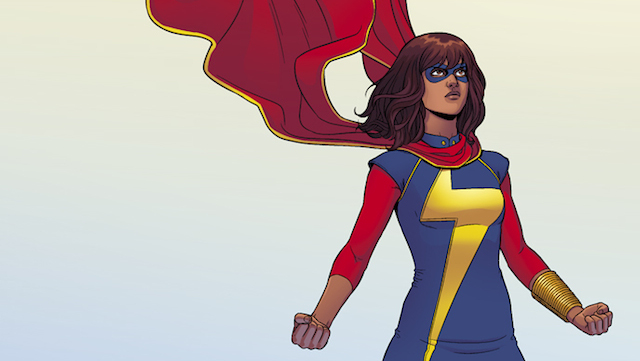Bursting on the scene with the exuberance of youth comes the new Ms. Marvel, superhero extraordinaire. Premiering from Marvel comics in February of 2014 the story starts with sixteen-year-old Muslim Kamala Khan living in a New Jersey where spandex heroes are commonplace celebrities. She spends most of her time writing stories about them. Or hanging out with her friends at the 7/11 EXPY. After sneaking out for a night on the town, Kamala acquires shape-shifting and healing abilities. Now instead of only having to balance her identity as an American teenager with her Pakistani background and her faith, Kamala also has to balance it with new superhero responsibilities. Naming herself in honor of her favorite superhero, the blonde Captain Marvel who can lift cars over her head, Kamala decides to actively help her community, in the same way that the heroes she admired from behind her computer screen do.
Though not the first Muslim superhero in the Marvel universe, Kamala Khan is the first to have her own title. The talented writer G. Willow Wilson, artist Adrian Alphona, and editor Sana Amanat–who comes from a similar background as Kamala–work on the book. This helps create the realistic grounding for what is a fun fantastical premise. With her abilities, Kamala could chose to look like anything, which makes it that much more important that she choses to still look like herself.
When people recommend the new Ms. Marvel they talk about how original the title is. The story of a sheltered Pakistani American superhero with something to prove certainly isn’t one we get everyday. The discussions within the book about trolling, internet fan culture, and what it means to be Muslim in America are all more clearly relevant to the modern age than many other contemporary superhero stories.
However, the ways in which the work really shines are in the combinations of the old world of comic books with these newer socially relevant view-points. Kamala Khan, in fact, has more in common with what came before than is usually admitted. That’s because we genuinely love and want to celebrate this book, and so tend to stress its originality. But the use of familiar tropes should not by itself be seen as automatically problematic. It’s problematic only when these tropes aren’t given the breathing room they need for creativity to shine through. When a hero has to be a certain way because of old genre conventions, a story can end up strangled by its own pathos. And that’s not the case here.
With great power comes great responsibility is the Spider-Man mantra every moviegoer learns. Kamala comes up with her own: good isn’t a thing you are, it’s a thing you do. Her powers are played as a typical coming of age narrative. She’s sixteen and her body starts doing strange things beyond her control. She’s insecure about her looks, only to find herself suddenly able to shape shift. Her parental guardians love her but can’t possibly understand what she’s going through. Spider-Man. The story we’re deja-vu-ing on is Spider-Man.
But Spider-Man gets dated. We’ve seen so many variations of his story where only slight details are changed. At this point, superhero stories with a white dude dealing with his emotions on an explosive metaphoric level are boring. Though there’s some interest in seeing how storytellers pick at these narratives for new material, goodness, by this point it’s a little like beating a dead horse. Story elements start to lose their punch. In the 1960s the idea of a father disapproving of his daughter dating a nerd seemed more reasonable. In the most recent Spider-Man movie, the writers had to incorporate the idea of mental instability to initially explain Captain Stacy’s dislike of Peter Parker. Now Marvel studios has been given the opportunity to reincorporate the character into the cinematic Marvelverse and we’re going to see him struggle for the third time in thirteen years. Even the casual fan has to sigh at the state of the story.
Superman has similar difficulties connecting to an audience in the modern age. The multitude of his powers combined with his strong moral compass makes him a difficult egg to crack for DC Comics. The most recent solution that I’ve enjoyed has again taken him to this place of immaturity. The Spider-Man coming of age narrative is used as a young Clark Kent discovers and struggles to control his new powers in Smallville. Clark Kent sees a pretty lady and his heat vision starts to act up! However, the show begins to struggle as the cast grows older because they are trapped within the confines of this already established narrative. Clark has to become Superman. No matter how a character might grow over the course of a television decade their eventual place in the universe has a set path a writing team doesn’t have the power to change. This transforms characters like Lex Luthor, or hey inevitable Green Goblin Harry Osborn, from tragedies to foregone conclusions.
Ms. Marvel is a good story because it uses cliché superhero origins not as a crutch but as a spinal column on which to attach the meat of characterization. Kamala is carefully created to be relatable without having to veer into bland, to be admirable without being inhuman (though she is in fact an Inhuman). She is new and her supporting characters could be almost anything. Even so, the patterns they present are familiar to our brains. One character is the locked-out-of-the-loop best friend. Another is the beleaguered secret keeper. Kamala is going to struggle with her identity, her place in the world, and her new responsibilities. Presumably she may lose things she cares about and make mistakes. But the fun is not knowing what those mistakes are going to be.
So yeah. Go read it. I dare you.

Leave a Reply